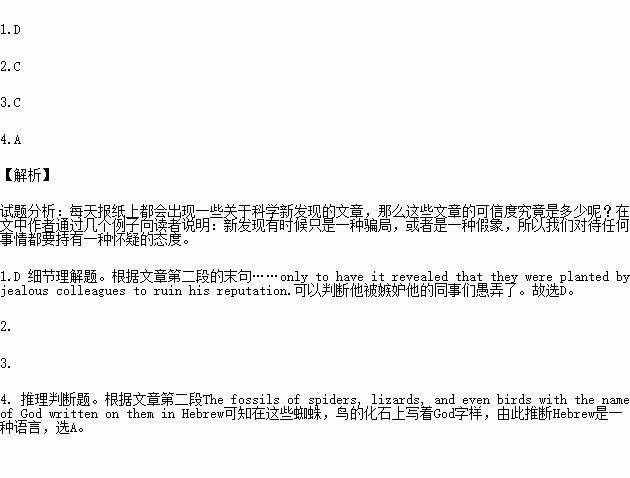题目内容
阅读理解
Can you believe everything that you read? It seems as if every day, some new articles come out about a new discovery about this or that. For example, water is bad for you, or good for you. The answer depends on which scientific study has just come out. People cannot decide which food items are healthy, how pyramids were constructed, and why dinosaurs disappeared. When we look for answers we sometimes can believe persuasive researches and scientists. But how trustworthy are they really? Here are two examples of scientific hoaxes (骗局).
As far back as 1726, Johann Beringer was fooled by his fellow scientists into thinking he had made an amazing discovery. The fossils of spiders, lizards, and even birds with the name of God written on them in Hebrew were unlike anything that had been found before. He wrote several papers on them and was famous for those only to have it revealed that they were planted by jealous colleagues to ruin his reputation.
When an early human being was discovered in 1912, scientists at this time were wild with excitement over the meaning it had for the theory of evolution. There were hundreds of papers about this Piltdown man over the next fifty years until it was finally discovered to be a complex hoax. The skull (头骨) of a man had been mixed with the jawbone of an orangutan (猩猩) to make the ape (猿) man.
The next time you read the exciting new findings of a study of the best scientist, do not automatically assume that it is true. Even qualified people can get it wrong. Though we certainly should not ignore scientific research, we do need to take it with a grain of salt. Just because it is accepted as the truth today does not mean it will still be trustworthy tomorrow.
1.What is the reason why Johann Beringer was fooled?
A. His fellow scientists wanted to make fun of him.
B. His workmates are eager to become famous too.
C. These scientists made a mistake because of carelessness.
D. His colleagues was jealous of him and did so to destroy his fame.
2.The excited scientists thought that this Piltdown man ________.
A. was in fact a complex hoax
B. was a great scientific invention
C. contributed to the theory of evolution
D. had the skull like that of an ape
3.What does the underlined phrase “with a grain of salt” in Paragraph 4 mean?
A. Happily. B. Generally.
C. Doubtfully. D. Completely.
4.What can we learn from the passage?
A. Hebrew is probably a kind of language.
B. Truths of science will never be out of time.
C. People believe scientists because they are persuasive.
D. We are advised to believe famous scientists.
 愉快的寒假南京出版社系列答案
愉快的寒假南京出版社系列答案
